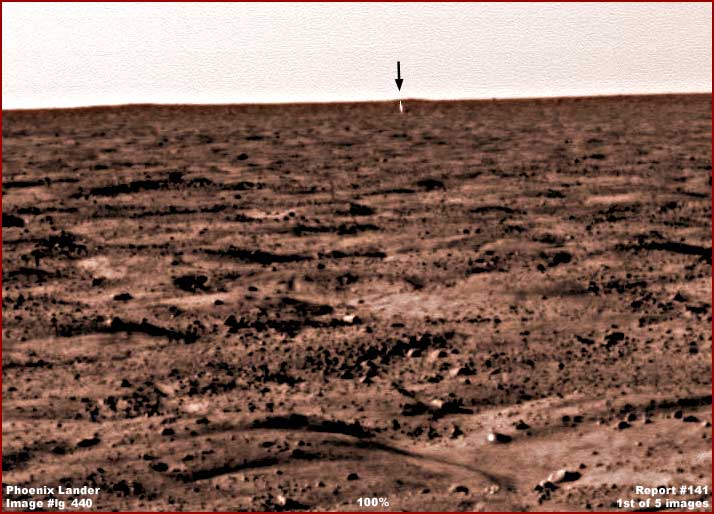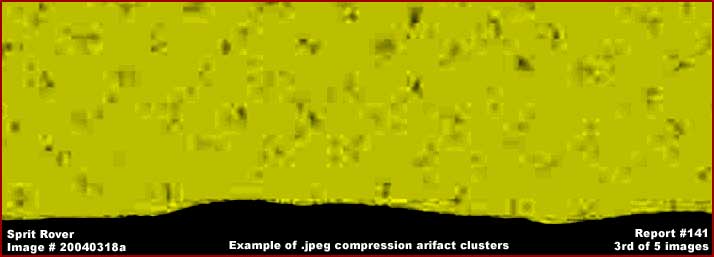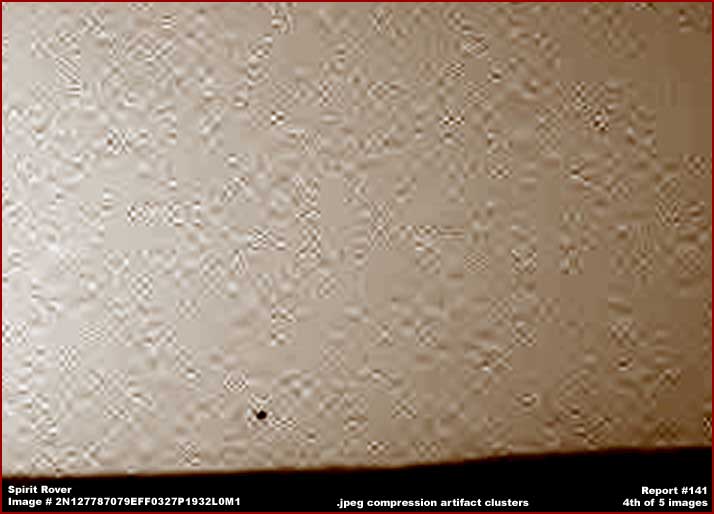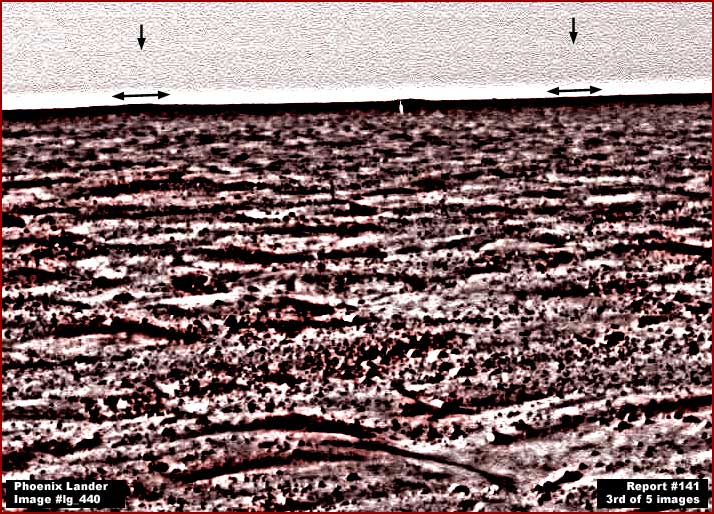
MARS PHOENIX LANDER QUESTIONS
Report #140
May 28, 2008

Here is my quicky report on the Phoenix Lander and some of its issues perhaps not covered by others. This is in response to a lot of email I'm getting requesting this, so here goes.
The above first image is a scene across a plain as seen from the Phoenix Lander reportedly newly landed successfully on Mars. As most of you no doubt know by now, the Phoenix Lander is a stationary lander that does not move around on Mars. It has a articulating arm and digger on the end of it much like backhoe machinery that can dig holes within reach near the lander to about two foot deep. It collects soil samples in this way around the lander and processes them in an onboard lab that then sends the raw data back to Earth. At least that's the well promoted story on it.
As you can see in the above image, the terrain around the lander is very empty and level off in the distance and appears to consist only of raw geological material otherwise known as rocks and soil. In the distance pointed out with the arrow is a bright white color vertically oriented object that stands out sharply in the background like a beacon saying look at me over here. For the most part this is the only anomalous looking object in this terrain around the lander and others have already noted this object in their reporting. Now below is a closer look at it.

As you can see in the above second image providing a 400% zoom factor closer look at the bright spot and, if you will get up close to the image and look very closely, this appears in this image to be associated with a darker organized object consisting of stacked layers. The bright vertial material appears be on this darker objects right side. That will no doubt fan the flames of speculation as to what this is and that it might be something alien or represent life.
As for me, I will admit that this looks very anomalous, at least in this imaging, but I have to say that I do not trust this image or the look of this object at all. If you will look closely around in the rest of the terrain you will see enlarged pixelation rectangles. These are artifacts the result of too much .jpeg compression at official level combined with the additional contrast I put on the image to get rid of the original official blurry quality as well as the considerable 400% zoom factor.
If you will look very closly, you'll see that the darker object is actually the same size as any one of the enlarged pixelation rectangles. That suggests that what we are looking at with the darker object is .jpeg compression artifact rather than something real. Well, if that is the case you might ask, why is this enlarged pixelation rectangle different than the others in the same terrain?
The bright white vertical area is the key to understanding this. My clarification work trying to bring out the darker object better, has subtly changed the shape of the white vertical area. In the original 100% view, the white vertical area is, in my opinion, vertically stacked empty pixels carelessly left when something was digitally removed or manipulated at this spot in the original image. When that is done, .jpeg compression artifacts tend to cluster closely at the spot when the image is subsequently compressed at official level and this has happened in the original image released to us here because of the official considerable .jpeg compression put on it.

In the above third image, you see an example of .jpeg compression artifacts clustering to many different spots in the sky and on the horizon line in the Spirit rover imaging. These are already present in the original raw images but visible only very faintly there. A great deal of contrast and color extremes brings them out where there are much more visible.
In my opinion, this is where stars and likely some artificial and/or natural objects have been eliminated from the sky. Any artificial or airborn natural objects for obvious reasons and the stars to prevent establishing familiar frames of reference and measuring points. The artifacts cluster to the spots where the original digital material has been disturbed in the obfuscation process. Note the very smooth areas that surround the artifacts. This is original sky digital realestate much less effected by the compression.

In the above fourth image, you see more examples of .jpeg compression artifacts with a difference. Note the consistent organized patterns within the clusters. Even though the Phoenix imaging represents improved and likely subtly differing technology, now compare those patterns with what appears to a darker object in report image #2 further above. This is what I suspect we are looking at where the darker object is at in image #2 but confined to a single enlarged pixel area. Note that the pattern there is very similiar to the above artifacts giving a look of having levels.
This suggest that something small and unacceptable in the original official image as released to us may have been censored at that point in the distance. Either it was likely removed and/or perhaps covered over by the graphics software clone stamp tool. The point is that, as much as some would like this to be something anomalous, I seriously doubt that we are looking at anything real at that spot, only the left over digital signs of manipulation in the image.

The above fifth and last image is the same scene as in the official image and in my first report image here. The reason that it is confusing looking is because it has been hit several times with the PhotoShop sharp unmask filter tool. I normaly don't use filters but in this case it does reveal quickly what I want to point out.
Note the horizontal arrows placed within that clear narrow band of sky right above the horizon line and the clear of artifacts zone they point out separating sky and terrain. Just above that narrow clear band, you see many distant .jpeg compression artifacts all over the sky above that point showing a very distinct distant pattern. Now pixelation and .jpeg compression artifacts, if the scene is all original and natural and if too much contrast is put on it, will start appearing universally all over the entire scene because they are a result of the underlying pixel grid. On the other hand, if they cluster around a spot or appear only as an organized presence in only part of the scene, that is a good indicator that someone digitally intervened in the original at those spots or areas.
Note how very uniform and precise that narrow clear band just above the horizon line is and the same with the area of artifacts above it. Someone has been digitally messing with this image. If anything at all is real here, I suspect that the narrow clear band, being the most distant on the horizon and naturally indistinct as far as detail goes, is the real sky. Likewise, I suspect that everything above that narrow band is not real sky but is an artificial sky replacement resulting in the oh so uniform density of the artifacts displayed within it rather than go to the trouble of eliminating individual objects out of the sky as done in the older Spirit rover imaging.
So here we are again. This report winds up being mostly about image tampering and I hate doing that. However, since NASA, etc. has the media gateways liberally infused with publicity about the Phoenix Lander, it is popular with the public and so my email is full of asking me about my take on this. I tried ignoring the Phoenix landing and I've tried to resist doing this report because I suspected what it would be about. However, I'm also tired of answering so much email on Phoenix. I had hoped my Report #138 titled "Mars Phoenix Landing Sites" posted a month ago might head some of this off but it's not to be.
The fact is that I anticipated some time ago that little about the Phoenix Lander mission would be truthful, at least when it comes to reported visual evidence and I am still of that opinion. My research in the older MGS MOC data indicates that the publicly promoted landing sites are all very rough terrain (per my previous report) and not viable for Phoenix's landing. So, when I look at the empty level plain type terrain pictured in the current Phoenix imaging, there is no way that I can buy into this plain as real.
I suspect that, what ever the Phoenix mission will ultimately reveal publicly, it is something that has been decided upon long before the Phoenix craft ever set sail for Mars and has nothing to do with what ever is really going on with Phoenix on Mars. If they are smart, they will at least make out like it is revealing the presence of water ice in the soil and, if they are smarter, they may even throw in a little microbial life to sweeten the pot and turn the corner. To do this, they can just bounce their desired processed data here on Earth off of the orbiting Mars satellite with the appropriate signatures and codes and no scientists here on Earth end receiving them will be the wiser.
However, while I am satisfied that there is actually a real Phoenix mission to Mars, I seriously doubt that anything we're seeing in public releases is the real thing. What concerns me is what is the real Phoenix Lander actually doing, where is it at really, and why does it need to be surrounded by so much elaborate and complete secrecy? When this kind of complete secrecy wall prevails running major risks of discovery right under the science and academic community and public noses, it smacks of too much arrogance and/or desperation and I begin to get a very bad smell a rat feeling.
DOCUMENTATION
http://fawkes4.lpl.arizona.edu/images.php?gID=440&cID=8: This link takes you to The University of Arizona preliminary page for the official science data image that my 1sr, 2nd and 5th report images were sourced from. There you will also find the statitics for this image as well as thumbnails for the many other Phoenix Lander images.
http://fawkes4.lpl.arizona.edu/images/gallery/lg_440.jpg: This link takes you directly to the full official science data image at The University of Arizona for download that my 1st, 2nd and 5th report images were sourced from.
http://marsrovers.jpl.nasa.gov/gallery/press/spirit/20040318a/07-JG-01-pan-A074R1.jpg: This link takes you to the full very large NASA color mosaic image that NASA prepared for the media press. With strong contrast and color application to reveal the .jpeg compession artifact clusters, this is the source of my 3rd report image that consists of only a small portion of the larger original image.
http://origin.mars5.jpl.nasa.gov/gallery/all/2/n/010/2N127266163EFF0224P1513L0M1.HTML: This takes you to the opening page for the JPL black and white raw science data image that is the source of my 4th report image. Remember to click on the "View Full Image" link under the large thumbnail image to reveal the full size image.
, Investigator
![]()